Micro vs Macro Influencers: An Insight into Influencer Marketing
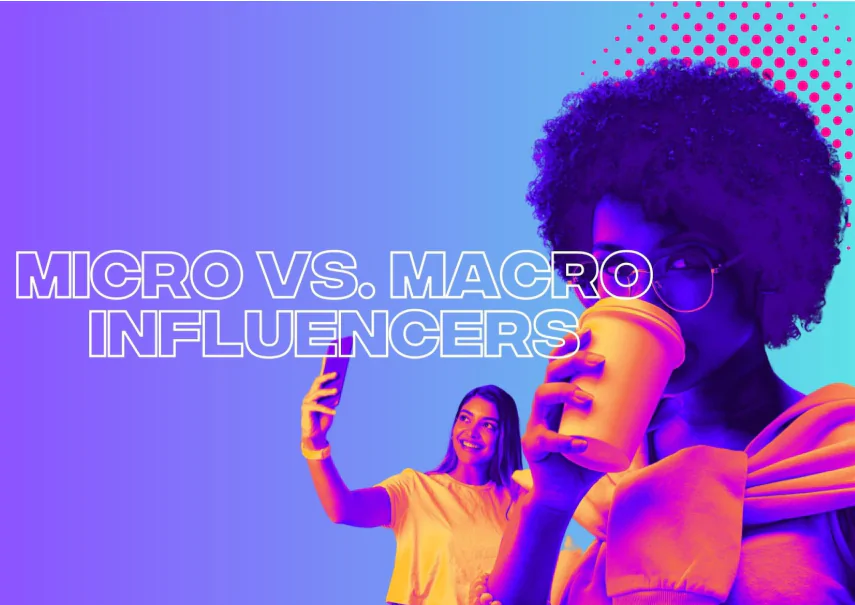
Micro vs Macro influencers: Learn how both serve a valuable and different purpose within influencer marketing, and which one is right for your brand strategy.

Each tier of influencer has its own set of benefits and drawbacks when it comes to potential reach, engagement rate, authenticity, and cost.
By learning the pros and cons of both micro and macro influencers, looking at real-world examples of use cases, and unpacking strategic factors including budget, brand alignment, campaign objective, and more, you’ll be poised to make an informed decision on which influencer type will best serve your brand’s needs.
But before we continue with our blog, let us tell you that we are not a regular agency; we are the leading influencer marketing agency in Mumbai. Fill in the given form and get a free consultation call from us.
Influencer Marketing Core: Types of Influencers

Influencer marketing has come a long way from celebrity endorsements. Creators are now ranked into distinct influencer tiers created by the size of their niche follower base. Nano influencers have 1k to 10k followers, micro influencers 10k to 100k, macro influencers 100k to 1m, and mega or celebrity influencers 1m+.
These tiers aren’t random. Those labels correspond to major differences in audience size, trust, content style, and expectations of cost. Brands consider quality of content, the consistency of posting, and rates of engagement: Likes, Comments, Shares- as primary metrics for finding an influencer who fits the bill. Getting a grasp on these layers is only the beginning.
It’s a necessary part of the foundation if you hope to make the most strategic decisions on what kind of Influencer you should be working with.
Understanding Micro-Influencers
While micro influencers have a much smaller reach than macro influencers (like celebrities), they have the highest engagement rate, with engagement rates declining with increasing follower size.
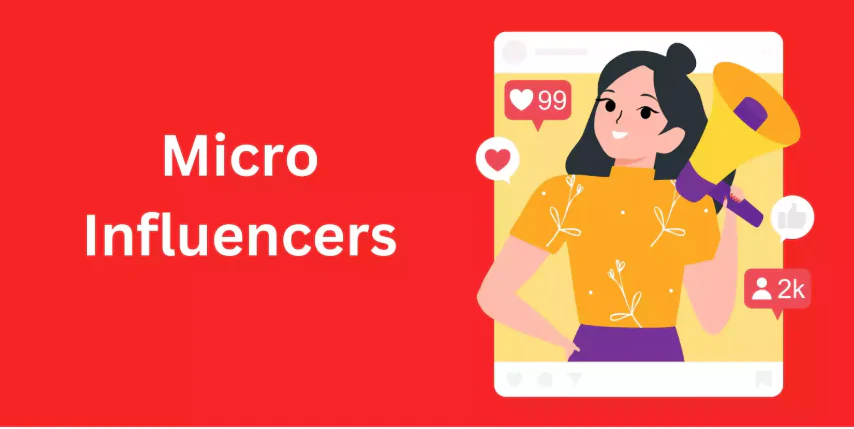
Micro influencers, who often represent the best connectors and networks, usually grow to 10,000-100,000 followers. What makes them truly powerful is their capacity to bubble up deeply connected communities based on trust and on-the-ground authenticity.
Micro influencers have a narrower reach and are therefore especially useful to brands looking to market to a specific niche.
From green beauty products, to niche hiking equipment, to small batch culinary treats, these influencers engage the most niche of niche, highly targeted audiences.
From a budget perspective, first-time collaborations tend to be a lot cheaper, from a few hundred dollars to a thousand dollars or so, so they’re an easier buy-in for smaller businesses. It might not always be pretty, but it is real-life life honest-to-goodness storytelling.
The catch here is in the limited reach; a post isn’t going to be an instant brand-scaler, and the production value of every piece of content differs by creator.
Despite this, if brands are looking for higher levels of consumer connection and more believable storytelling, micro influencers represent a powerful option.
The Impact of Macro Influencers

Macro influencers, specifically, those influencers with 100,000 to 1 million followers, provide broad reach and brand awareness.
Unlike our grassroots efforts, their glossy materials, built off pro-quality imagery and flowing messaging, speak to the big audiences.
Whether for brand awareness campaigns, new product launches, or seasonal promotions, macro influencers can deliver the extensive reach needed in ways that smaller micro influencers just don’t have. Since these partnerships generally come off as more commercial and strategic, the authenticity factor drops, resulting in lower engagement rates, usually 2% to 5%.
Furthermore, macro influencers require much higher payments, generally ranging from several thousand dollars to ten thousand dollars or more for a single post, which can create budget limitations for smaller brands. If you’re looking for the quickest, biggest impact possible, macro influencers are still a powerful force.
Infographic Illustrating the Differences Between Influencer Tiers
When you look at each type of influencer tier directly next to one another, the distinction is obvious. Nano influencers (1,000–10,000 followers) reach the smallest audiences but have the highest engagement. These influencers are powerful at the local level or within narrowly defined niches. Micro influencers (10K–100K) strike an ideal balance between engagement and reach. These
Influencers provide great results at a lower cost.
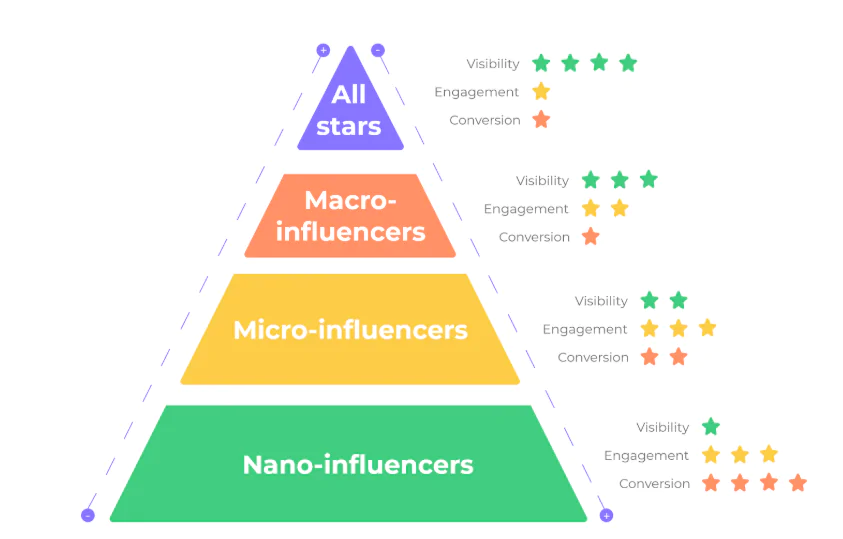
Macro influencers (100K–1M) command an impressive ability to reach great awareness but work at a much higher cost, with often lower engagement rates.
Mega influencers or Celebrities (1M+) bring the star power and visibility, but come with costs that can escalate to tens of thousands per engagement. For most brands, it’s a matter of matching goals with budget for which influencer tier to select.
Nano and micro tiers perform best when reaching niche markets with higher engagement. Macro and mega tiers work for wider, awareness-focused campaigns with larger budgets.
Influencers That Fit Your Brand
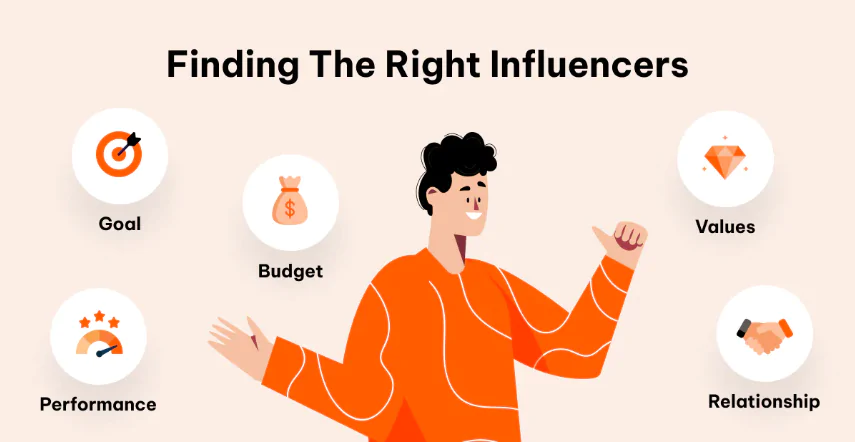
Choosing the right influencer, In some cases, choosing the right influencer isn’t all about the numbers—it’s about brand alignment sparked by authentic storytelling.
The influencer’s tone, values, and content style should align with your brand’s culture and voice. Their followers must reflect your target audience’s demographics, interests, and likes. A macro influencer with an incredible track record may produce little to no ROI.
Authentic alignment would be far more powerful than the follower count driven by ego. For example, a beauty brand looking to advertise sustainable makeup may be better off collaborating with a micro influencer who specialises in eco-friendly beauty advice instead of a macro influencer who rarely discusses sustainability.
Identify influencers and influencers whose storytelling style aligns with your brand narrative and whose audience is most likely to connect. This strong strategic fit means campaigns never feel contrived or invasive and drive longer-lasting results.
Influencer Reach vs Engagement Rate:
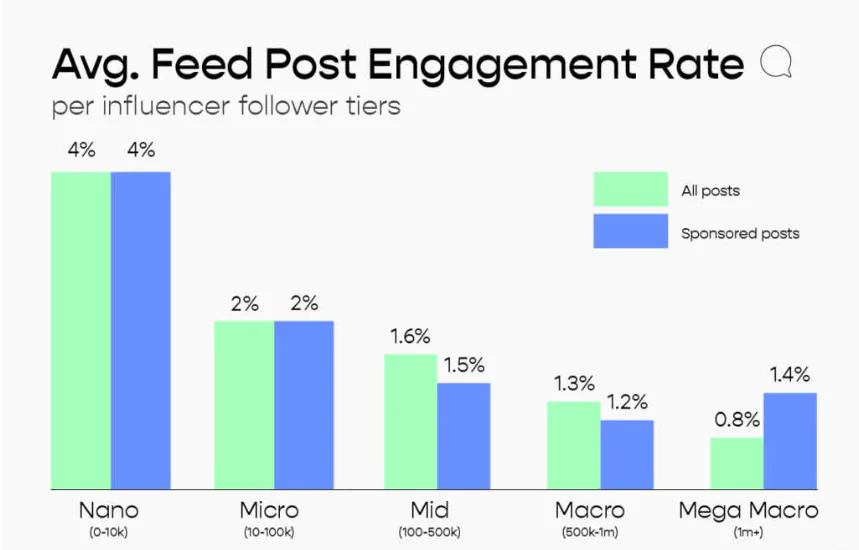
Brands often struggle with choosing between reach and engagement. These two metrics are used for different things.
Reach tells you how many people were reached by the content, and engagement tells you how many people interacted with the content.
For awareness-driven campaigns, brand launches, national promotions, or seasonal product introductions, reach trumps all.
This is where macro influencers shine. If the goal is to build trust, foster conversions, or integrate your product into relevant stories, then engagement is key.
Micro influencers often excel at this metric, making them best suited to campaigns where genuine interaction is key.
In the end, the best solution is usually a combination of the two. Perhaps you’d plan to launch your campaign by working with a cohort of macro influencers to reach a larger audience, then move to micro or nano influencers as you continue to develop interest and drive audiences to take action.
Budget vs Impact: Discovering the Right Balance

The focus for budgeting influencer marketing usually becomes value per dollar spent. To brands that have less room in their budgets, but want more measurable impact, micro influencers bring high engagement for a lower cost.
Macro influencers need a bigger investment but deliver quick, high-visibility results in a big way. ROI doesn’t necessarily go hand-in-hand with high spend.
A properly executed niche micro influencer campaign can garner far more conversions per dollar than a macro influencer campaign with poor engagement.
Brands need to measure campaigns differently: if the goal is long-term, continued brand-building, a campaign with multiple micro influencer collaborations will likely yield more effective long-term results than a one-time macro influencer post. When it comes to major launches or campaigns to create mass awareness, macro influencers can help to provide the noisy first signal that sets the stage.
Developing a Campaign Strategy Based on Influencer Size
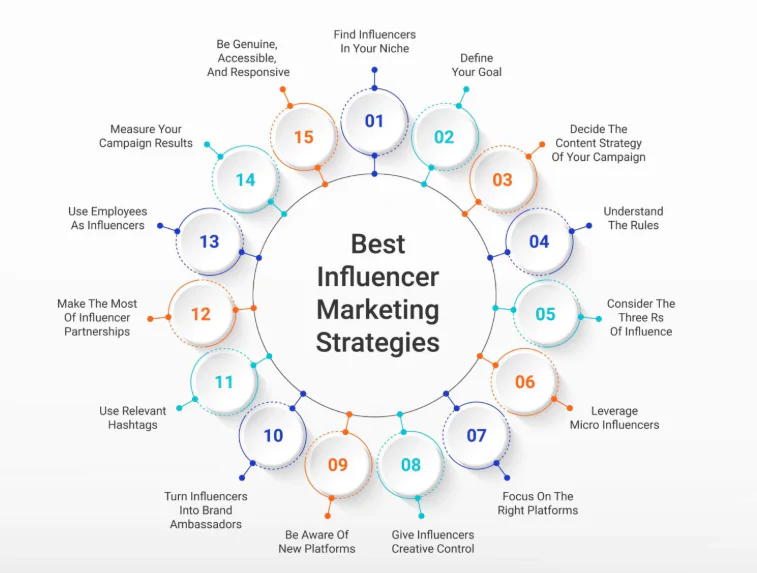
Savvy brands understand this and adjust their influencer strategy according to the different stages of the marketing funnel.
At the top of the funnel, macro and mega influencers are powerful because they can go far and deep, creating a thunderclap of hype and awareness.
On consideration, micro influencers are key, offering more meaningful product experiences and brand stories that build trust with their audience.
At the bottom of the funnel, during conversion and loyalty, nano and micro influencers perform best to drive purchases, generate user-generated content, and build community.
With the power of a multi-tiered approach at their side, brands can lead their audiences smoothly from discovery to advocacy.
Take, for example, a new product launch by a well-known brand. They might kick it off with macro influencers announcing the product, then later activate micro influencers to show how it works in real life, and finally re-share UGC from nano influencers to establish trust and facilitate sales.
How to Avoid Common Influencer Strategy Pitfalls

Even pros like marketers can still trip. One common pitfall to watch out for? Prioritizing pure follower reach over engagement rate. An impressive million followers is useless if no one ever engages with the content. The other major pitfall is not keeping audience alignment in mind; a misaligned voice can be fatal to your brand messaging.
Most brands significantly underestimate the efficacy of legacy content, all while influencers with heavy-handed CTAs or badly matched sponsorships put you at increased risk.
Failing to fully vet authenticity, content style, and audience demographics results in campaigns that can come off as disingenuous, provide poor ROI, or worse, create a negative response.
Staying vigilant during the influencer selection and vetting process prevents you from falling into these minefields.
Last Word

There is no one-size-fits-all solution, no better micro vs macro influencers. Your decision depends on your overall campaign objectives, brand voice, audience, and budget. If your primary aim is engagement, authentic, story-driven marketing, and a long-term build of trust, micro influencers tend to deliver the highest value for every dollar spent.
We are the next in to move up on a level of marketing to start with the new things and are also forward looking towards at the end of working in the working of the at the ned moment like a hero of ourself he coes up to is and then start to talk with the most of the anf also very honest of the boys in the looking like star phase and are also most of the most in the non chalant and also we are looking in the most.
Drop us a note if you want to help improve any of the chapters. Simply fill out the form, and let’s boost your ROI.



